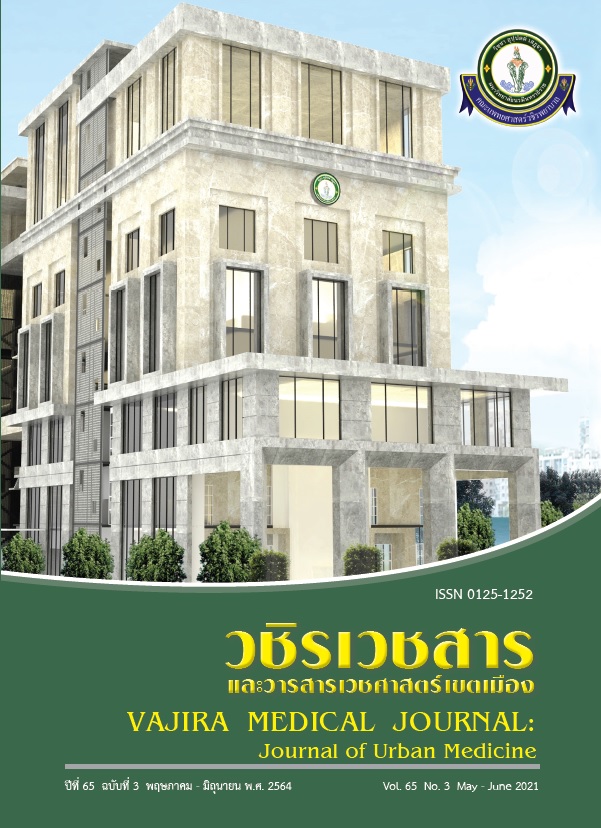Development of Equation for Calculated Osmolarity in the Older Thai Elderly Urban Emergency Department Patients and its Accuracy
Main Article Content
Abstract
Background: Older people are more susceptible to dehydration owing to their physiological changes and down-regulated thirst response. In the literature, serum osmolarity remains the gold standard for diagnosing water-loss dehydration. This study aimed to develop an equation specifically for calculating osmolarity in older Thai adults. Furthermore, our study compared the accuracy of the proposed equation with that of previously published equations.
Methods: This study was a secondary analysis of a prospective cohort study. We enrolled all the patients aged ≥65 years who visited our emergency department (ED) during the period from May 15, 2017, to July 31, 2017. We used linear regression to develop a new calculated osmolarity equation from the patients’ laboratory data compared with the measured serum osmolarity. In a receiver-operating characteristic (ROC) plot, the new equation was compared with other 5 equations in terms of its ability to diagnose dehydration (calculated osmolarity > 300 mOsm/kg). The Bland-Altman method was used to assess the mean difference (MD) with each equation.
Results: A total of 322 participants were included in the study. The new equation originated from our older patients’ data was 1.75 × (Na + K) + 0.9 × Glucose + Urea + 25.7, all in mmol/L. This equation had the highest ROC-area under the curve (AUC) of 0.81 among all the equations. The MD between the calculated and measured osmolarity values was 0.49 mOsm/L (95% confidence interval [CI], −0.40 to 1.38 mOsm/L). Equations 1, 2, 3, 4, and 5 showed ROC-AUC of 0.73, 0.78, 0.75, 0.80, and 0.81, respectively. The MDs (95% CI) were 6.18 (5.13–7.23), −4.19 (−5.15 to −3.23), −5.38 (−6.37 to −4.39), −5.31 (−6.20 to −4.41), and −6.89 (−7.8 to −5.98), respectively.
Conclusion: We developed a new equation with good performance in calculating osmolarity. However, further validation and ability to predict dehydration of this equation should be assessed.
Downloads
Article Details
References
Rikkert MGMO, Hoefnagels WHL, Deurenberg P. Age-related changes in body fluid compartments and the assessment of dehydration in old age. Hydration and Aging 1998:13-32.
Rowe JW, Shock NW, DeFronzo RA. The influence of age on the renal response to water deprivation in man. Nephron 1976;17(4):270-8.
Mack GW, Weseman CA, Langhans GW, Scherzer H, Gillen CM, Nadel ER. Body fluid balance in dehydrated healthy older men: thirst and renal osmoregulation. J Appl Physiol (1985). 1994;76(4):1615-23.
Thomas DR, Cote TR, Lawhorne L, Levenson SA, Rubenstein LZ, Smith DA, et al. Understanding clinical dehydration and its treatment. J Am Med Dir Assoc 2008;9(5):292-301.
Hooper L, Bunn D, Jimoh FO, Fairweather-Tait SJ. Water-loss dehydration and aging. Mech Ageing Dev 2014;136-137:50-8.
Wakefield BJ, Mentes J, Holman JE, Culp K. Risk Factors and outcomes associated with hospital admission for dehydration. Rehabilitation Nursing Journal 2008;33(6):233-41.
Rikkert MGMO, Melis RJF, Claassen JAHR. Heat waves and dehydration in the elderly. BMJ 2009;339:b2663.
Bhalla A, Sankaralingam S, Dundas R, Swaminathan R, Wolfe CD, Rudd AG. Influence of raised plasma osmolality on clinical outcome after acute stroke. Stroke 2000;31(9):2043-8.
Manz F. Hydration and disease. J Am Coll Nutr 2007;26(5 Suppl):S535-41.
El-Sharkawy AM, Watson P, Neal KR, Ljungqvist O, Maughan RJ, Sahota O, et al. Hydration and outcome in older patients admitted to hospital (The HOOP prospective cohort study). Age Ageing 2015;44(6):943-7.
Hooper L, Bunn DK, Downing A, Jimoh FO, Groves J, Free C, et al. Which frail older people are dehydrated? The UK dRIE study. J Gerontol A Biol Sci Med Sci 2016;71(10):1341-7.
Stookey JD. High prevalence of plasma hypertonicity among community-dwelling older adults: results from NHANES III. J Am Diet Assoc 2005;105(8):1231-9.
Fortes MB, Owen JA, Raymond-Barker P, Bishop C, Elghenzai S, Oliver SJ, et al. Is this elderly patient dehydrated? Diagnostic accuracy of hydration assessment using physical signs, urine, and saliva markers. J Am Med Dir Assoc 2015;16(3):221-8.
Hooper L, Abdelhamid A, Attreed NJ, Campbell WW, Channell AM, Chassagne P, et al. Clinical symptoms, signs and tests for identification of impending and current water-loss dehydration in older people. Cochrane Database Syst Rev 2015(4):Cd009647.
Hooper L, Abdelhamid A, Ali A, Bunn DK, Jennings A, John WG, et al. Diagnostic accuracy of calculated serum osmolarity to predict dehydration in older people: adding value to pathology laboratory reports. BMJ Open 2015;5:e008846. doi: 10.1136/bmjopen-2015-008846.
Buaprasert P, Piyapaisarn S, Vanichkulbodee A, Kamsom A, Sri-on J. Prevalence and risk factors of hypertonic dehydration among older patients admitted to the emergency department: A prospective cross-sectional study. Geriatr Gerontol Int 2021:e1-7. doi: 10.1111/ggi.14168.PubMed PMID: 33847031.
Fazekas AS, Funk G-C, Klobassa DS, Rüther H, Ziegler I, Zander R, et al. Evaluation of 36 formulas for calculating plasma osmolality. Intensive Care Medicine 2013;39(2):302-8.
Warren JL, Bacon WE, Harris T, McBean AM, Foley DJ, Phillips C. The burden and outcomes associated with dehydration among US elderly, 1991. American Journal of Public Health 1994;84(8):1265-9.
O’Neill PA, Faragher EB, Davies I, Wears R, McLean KA, Fairweather DS. Reduced survival with increasing plasma osmolality in elderly continuing-care patients. Age and Ageing 1990;19(1):68-71.
Berendsen A, Santoro A, Pini E, Cevenini E, Ostan R, Pietruszka B, et al. A parallel randomized trial on the effect of a healthful diet on inflammageing and its consequences in European elderly people: design of the NU-AGE dietary intervention study. Mech Ageing Dev 2013;134(11-12):523-30.
Edelman IS, Leibman J, O’Meara MP, Birkenfeld LW. Interrelations between serum sodium concentration, serum osmolarity and total exchangeable sodium, total exchangeable potassium and total body water. J Clin Invest 1958;37(9):1236-56.


